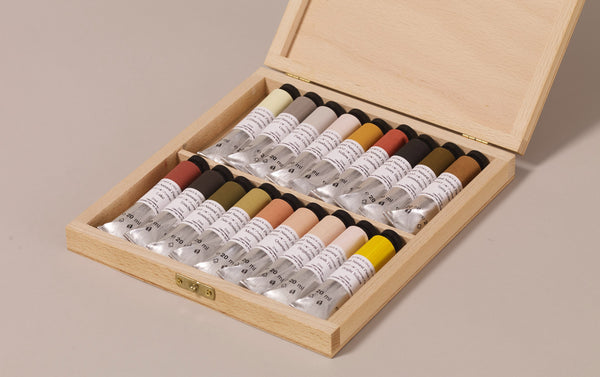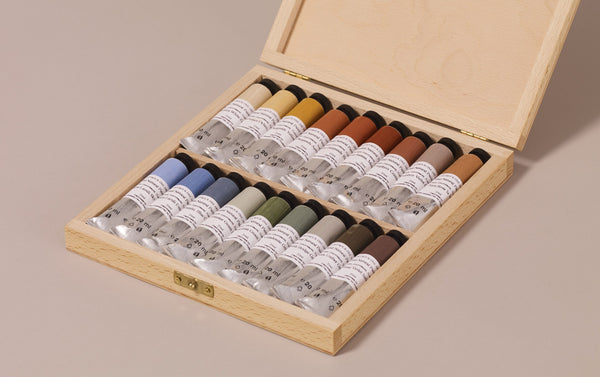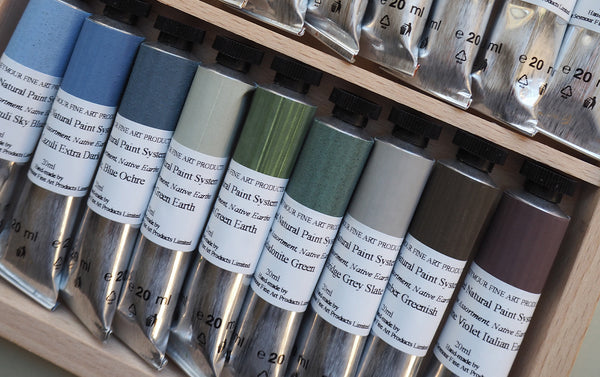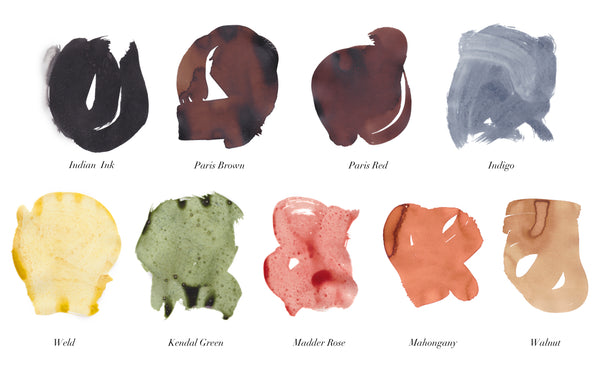Natural Pigment Oil Landscape Set
£425.00
From the studio of our most respected pigment experts, Pip Seymour and Rebecca Wallace, we are pleased to offer this professional grade oil paint box. In the face of declining quality due to mass manufacturing, as artists themselves, they began making paints to their own tastes and recipes looking to emulate art materials from the past, with more individuality and natural appearance.
These are formulated using 100% natural pigments sourced from sustainable materials from either rocks, mineral and earth deposits - milled in cold pressed linseed oil from a single farm estate in England. Cold pressed (as opposed to refined) linseed oil is a premium material used only by the best art material companies for its clarity and ability to realise bright colour resonance. Once dried linseed oil also affords a long-lasting hard and durable gloss effect (preferable to matte finishes which attract dust and dirt)
The pigments selected for this 18 tube assortment have been designed with landscape painting specifically in mind.
Details:
Material: 18 x Oil Paint 20ml tubes
Lightfastness: Permanent once dried.
Included: A wooden presentation box
Vegetarian: yes
Vegan: yes
Pigments:
Vincenza white earth - A natural white earth pigment mined from a long standing working quarry in the Veneto region of northern Italy; largely made from clay deposits this is a soft, warm grey.
Provence ochre, palest - Ochre refers broadly to a pigment found worldwide, comprised from clay and/or sand which is tinted by the oxidisation of natural ferric (iron) present in the mineral. Paler shades contain more chalk; this particular pigment is mined from a working quarry in Provence in the south of France.
Puisaye Burgundy, yellow ochre - This darker shade of ochre, in comparison to the paler above, shows how the pigment varies according to source. Mined again from a French working quarry where it has been extracted for many centuries, the colour is a warm mustard yellow.
Puisaye Burgundy, apricot ochre - A rustier shade than its yellow counterpart this is another tonal variety of ochre mined at Puisaye. One of the oldest pigments in history, the more orange tones are familiar to cave paintings.
Puisaye Burgundy, red ochre - The darkest shade of ochre in this palette - red ochre is made with the common iron compound known as hematite which can be etymologically traced from the ancient greek haimatitēs lithos meaning “blood-red stone”.
Burnt sienna, Monte Amiata - taking its name from the city of its production during the Renaissance, Siena, this pigment was one of the first used by humans. This burnt sienna was mined in the 1970s, close to its Renaissance namesake at Bagnoli, a Tuscan village in the shadow of Monte Amiata - the quarry is long closed; this particular pigment is finite.
Porphyry crimson - mined from a working quarry, porphyry refers to the texture of igneous rocks that have a large grain crystal formations (such as quartz). Whilst more commonly used to refer to the purple-red form, this colour is a soft red-brown.
Porphyry violet grey - Similar to the above, this is a softer purple-grey tone; mined again in a working quarry that has been operating for centuries.
Terra Rosa ‘la vena’ - Literally the Italian for ‘red soil’ this pigment is comprised from a red clay produced by the weathering of limestone. This particular pigment is collected from the Sesti Vineyard in the south of Tuscany; the harvest of which is a byproduct of the wine industry.
Lapis lazuli sky blue - Traditionally known as ultramarine which literally translates to ‘across the sea’ - Lapis was first sourced from the valley of the Kokcha river in north-eastern Afghanistan. Used prolifically during the Renaissance, the mineral is still mined by hand.
Lapis lazuli extra dark - A darker shade of lapis than the above; the tonal difference is due to the different source/ quality of mineral as well as the processing of the raw material. The lapis used by Wallace Seymour is mined in cooperation with a working quarry.
Vivianite, blue ochre - Whilst pure Vivianite is colourless, it oxidises with ease and is known for its blue-green tone and has been used in painting in some capacity since the Roman times - mined here today in cooperation with a working quarry.
Honister green earth - Green Earth is a natural earth pigment that has existed since antiquity; its tone varies according to source. At Honister, in the lake district, you can find the last working slate mine in England - this soft grey-green is a byproduct of the mining industry there, otherwise destined for landfill.
Bohemian green earth - Sourced from the Czech Republic this is a darker shade of Green Earth where this shade has been mined for centuries in tradition.
Celadonite green - Celodine is of the Mica mineral group which is very commonly used in paint production; typically for more metallic and pearlescent tones this is a soft matte green with some nice granulation.
Helwith bridge grey slate - Mined from a historic working slate quarry in Helwith Bridge in the Yorkshire Dales.
Raw umber greenish - A dark green-grey, umber takes its name from Umbria, the central Italian region where this pigment was first mined for artistry. It is an ancient pigment which can have great tonal variation depending on the source.
Morellone violet Italian earth - an iron oxide pigment which washes towards a deep violet-purple. Mined from a traditional working quarry.





